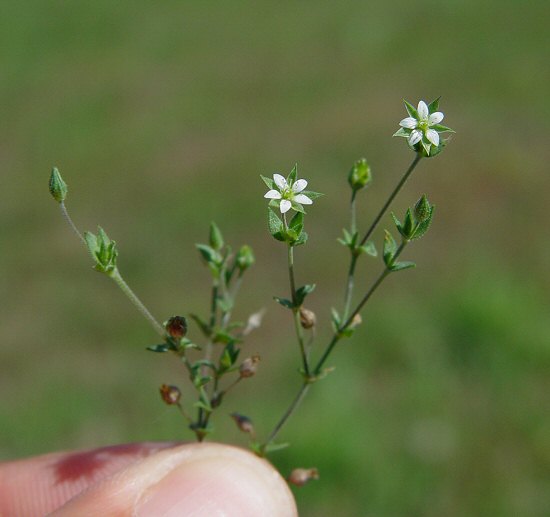Arenaria serpyllifolia L.
Thyme-Leaved Sandwort

Introduced
CC = *
CW = 3
MOC = 66
© DETenaglia
Arenaria serpyllifolia L.Thyme-Leaved Sandwort | |
 |
Introduced CC = * CW = 3 MOC = 66 |
© DETenaglia |
|
Family - Caryophyllaceae Habit - Taprooted annual forb. Stems - Sprawling to erect, to 45 cm, usually branched, moderately pubescent with minute, downward-curved hairs, sometimes also stipitate-glandular.
Leaves - Opposite, fused basally into a sheath, usually sessile. Leaf blades 2-7 mm long, elliptic to broadly ovate, tapered at the base, acute, entire, glabrous.
Inflorescence - Axillary single flowers or terminal loose cymes. Pedicels elongating in fruit to 1 cm, retrorsely pubescent. Bracts paired, leaflike.
Flowers - Sepals 5, 2-3 mm long, becoming elongated to 4 mm long at fruiting, free or basally fused, lanceolate to narrowly ovate, sharply pointed, the margins thin and whitened. Petals 5, free, usually shorter than the sepals, 0.6-2.7 mm long, oblong, not tapered to a stalklike base, entire at the tip, white. Stamens 10, the filaments white, glabrous, distinct. Pistil with 1 locule, sessile. Styles 3, white, glabrous, each with the stigmatic area along the inner surface. Ovary superior, green, glabrous, 1.5 mm long, 1 mm in diameter, unilocular. Placentation free-central.
Fruits - Capsules, 3.0-3.5 mm long, dehiscing apically by 6 ascending to recurved teeth. Seeds 10-15, 0.3-0.6 mm wide, kidney-shaped, the surface tuberculate, black.
Flowering - April - August. Habitat - Glades, fields, bluffs, roadsides, railroads, disturbed areas. Origin - Native to Europe. Lookalikes - Chickweeds (Cerastium spp., Stellaria spp.). Other info. - This tiny plant is common throughout most of Missouri and large portions of the continental U.S. It is small and inconspicuous, and often overlooked, although large populations can be showy in their own way on warm, sunny spring days. This species can be identified in the field by its small, opposite, ovate leaves and its small white petals, which are smaller than the sepals. Photographs taken in Gainesville, FL., 2-11-03, and at Providence Prairie, Lawrence County, MO., 6-18-05 (DETenaglia); also along the Katy Trail west of Augusta, St. Charles County, MO, 5-12-2017, and near Labadie, Franklin County, MO, 4-24-2020 (SRTurner). |